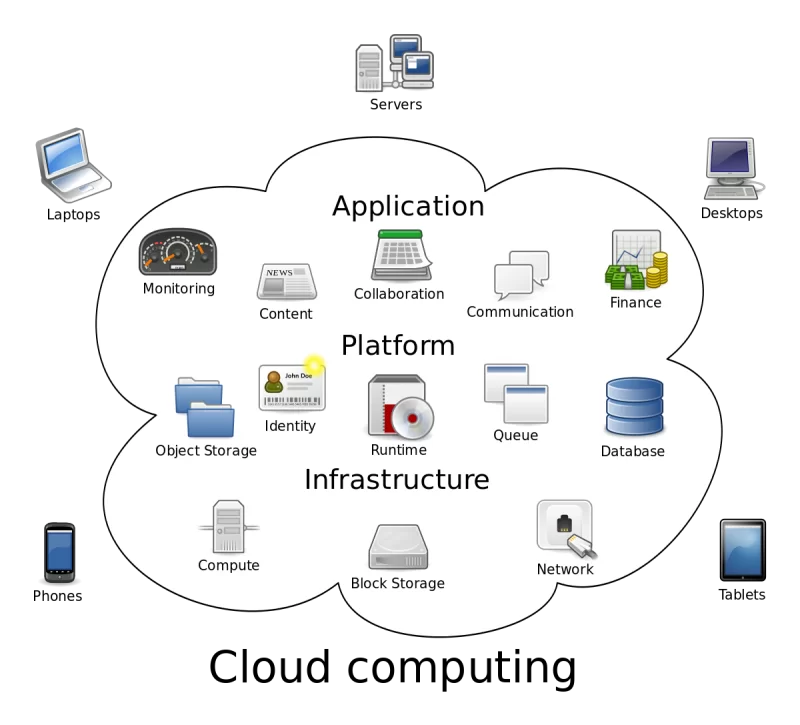Given the ever-evolving digital online marketplace, it’s worth mentioning that Cloud Computing Technology is an on-demand service that has obtained mass appeal in corporate data centers and hosting environments. The cloud enables the data center to operate like the Internet, and computing resources can be accessed and shared as virtual resources in a secure and scalable manner.
Like most technologies, the cloud computing trends start in the enterprise and shift to adoption by small business owners. For small and medium-sized businesses (SMBs), the benefits of cloud computing are currently driving adoption. The SMB sector often lacks time and financial resources to purchase, deploy, and maintain an infrastructure (e.g., the software, server, and storage).
It’s worth noting that many people believe the term cloud computing technology is just another buzzword used to describe too many technologies. As a result, they often make it too confusing for even professional design webmasters to understand. Moreover, when most people use the term, they may have one of these ideas in mind, but the listener might be thinking about something else.
Cloud Computing has emerged as a game-changer across various business industries in recent years, and cloud gaming is no exception. It has revolutionized online casinos, offering unparalleled scalability, flexibility, and efficiency. We’ll explore how cloud computing technology is transforming the landscape of online digital presence, enhancing user experiences, and streamlining business operations.
Understanding What Cloud Computing Technology Offers
The term ‘cloud computing’ has been used over the years to mean several technologies. This includes grid computing, utility computing, software-as-a-service (SaaS), Internet-based applications, autonomic computing, peer-to-peer computing, and remote processing. In other words, the term ‘cloud’ denotes a computing platform outside an organization’s firewalls on shared systems.
In Cloud Computing, the word “cloud” (also phrased as “the cloud”) is used as a metaphor for “the Internet.” So, the phrase cloud computing means a type of Internet-based computing. Even though you’re on a journey with no shortage of complexity, different services — including servers, storage, and applications — are delivered to an organization’s computers and devices through the Internet.
It’s important to realize that in most scenarios, your cloud service provider controls the cloud computing infrastructure that helps drive your digital online business operations. Cloud Computing delivers services, servers, storage, databases, networking, software, analytics, intelligence, etc. Particularly over the Internet to offer faster innovation, flexible resources, and economies of scale.
Key Features:
- Innovation
- Reliability
- Flexibility
- Cost & Scale
- Choice
- Opportunities
- Agility
- Savings
- Efficiency
- Performance
In addition, you typically pay only for the cloud services you use. After all, this helps lower your operating costs, run your infrastructure more efficiently, and scale up during a business change. To give you an idea, you can learn more about what IBM offers digital online businesses for more helpful information—a faster and more secure journey to the cloud.
Regarding Cloud Computing Technology hubs, small businesses can access these resources using an Internet connection and a Web browser. You can expand (or shrink) services as your business needs change. In contrast, a private cloud is the same platform. However, it is implemented within the corporate firewall, under the control of the organization’s IT department.
A private cloud is designed to offer the same features and benefits as public cloud systems. However, it removes several objections to the computing model, including control over corporate and customer data, security concerns, and regulatory compliance issues.
The Topmost Applied Cloud Computing Technology Solutions
An example of a cloud computing file storage provider is Dropbox. Dropbox files can be accessed from any device via the Internet. In other instances, on-premises or off, public or private, bare metal or multi-cloud, IBM Cloud makes it faster and easier to create innovative experiences with the latest technologies. Equally important, you can build new Artificial Intelligence (AI) applications quickly.
Remarkably, these AI-driven systems learn from every interaction, modernize core systems with microservices, and lift and shift VMware apps without massive rework. In addition, an exemplary data architecture provides a solid foundation for AI to improve organizational processes, create enriching customer experiences, and pursue new business revenue streams.
Through cloud computing technology, developers can streamline the process of website design, application development, and deployment for online digital businesses. Game developers can leverage cloud resources to collaborate on real-time projects, reducing development cycles and time-to-market. In addition, cloud platforms offer robust regression testing environments.
As a result, developers can fine-tune games for optimal performance and user experience. This efficiency benefits online casinos and players, ensuring a steady flow of new and engaging games. Markedly, the IBM Cloud is designed to make your life easier. In particular, it offers the right tools that integrate, broker, and give webmasters greater visibility across all their vendors.
Learn More: How Web Applications Work | With Example & Use Benefits
This also helps cloud-based businesses and IT-powered organizations to maximize the value of their new and existing investments. Remember, not all clouds are the same, and not one type of cloud is suitable for everyone. However, while cloud services work differently, many provide a friendly, browser-based dashboard that makes it easier for IT professionals and developers to utilize.
In layman’s terms, this seamless integration process helps them order resources and manage their accounts. Today, several cloud computing technology tools, models, styles, and services have evolved to help offer the right solution for your needs. You need to determine the type of cloud deployment, or cloud computing architecture, that your cloud services will be implementing.
Public Cloud
Public clouds are owned and operated by third-party cloud service providers, which deliver computing resources like servers and storage over the Internet. For beginner webmasters, Microsoft Azure is an excellent example of a public cloud. With a public cloud, the cloud provider owns and manages all hardware, software, and other supporting infrastructure. You access these services and manage your account using a web browser.
Private Cloud
A private cloud refers to computing resources used exclusively by a single business or organization. A private cloud can be physically located in the company’s on-site data center. Some companies also pay third-party service providers, such as Bulk Nordic Data Centers, to host their private cloud.
Hybrid Cloud
Hybrid clouds combine public and private clouds. Specifically bound together by technology that allows data and applications to be shared between them. Eventually, by allowing data and applications to move between private and public clouds. A hybrid cloud gives your business greater flexibility and more deployment options and helps optimize your existing infrastructure, security, and compliance.
IaaS, PaaS, Serverless, and SaaS
Most cloud computing services fall into four broad categories, including Infrastructure-as-a-Service (IaaS), Platform-as-a-Service (PaaS), serverless, Software-as-a-Service (SaaS), and other related business models or solutions. They are also called cloud computing stacks because they build on top of each other. Knowing what they are and how they’re different makes it easier to accomplish your business goals. In addition, cloud computing services have several common attributes.
Some Include:
- Virtualization: Utilizing the server and cloud storage virtualization extensively. Especially in allocating and or reallocating resources rapidly.
- Multi-tenancy: Pooling and sharing the resources among multiple users, gaining an economy of scale.
- Network access: Accessing resources via a web browser or thin client using various networked devices (computer, tablet, smartphone).
- On-demand: Self-provisioning resources from an online catalog of pre-defined configurations.
- Elastic: Automatically scaling the resources down or up.
- Metering/chargeback: Tracking and billing of the resource usage based on the service arrangement
Among the many types of cloud computing services delivered internally or by third-party service providers, the most common are:
Infrastructure as a Service (IaaS)
To point out, this is the most basic category of cloud services. With Infrastructure-as-a-Service (IaaS), you rent IT infrastructure servers and virtual machines (VMs)—the storage, networks, and operating systems from a cloud provider on a pay-as-you-go basis. Learn more about What IaaS Is in detail.
Software as a Service (SaaS)
In this case, Software-as-a-Service (SaaS) is a method for delivering software applications over the Internet. Especially on-demand and typically on a subscription basis. Moreover, cloud providers host and manage the software application and underlying infrastructure with SaaS. Additionally, they handle any maintenance like software upgrades and security patching. In this case, users connect to the application over the Internet. Usually with a web browser on their phone, tablet, or PC.
Platform as a Service (PaaS)
In reality, a Platform-as-a-Service (PaaS) refers to cloud services that supply an on-demand environment, such as for developing, testing, delivering, and managing software applications. They are seamlessly designed to make it easier for developers to create web platforms and mobile apps, especially without worrying about setting up or managing the underlying infrastructure of servers, storage, networks, and databases needed for development.
Serverless Cloud Computing
Overlapping with PaaS, serverless computing focuses on building app functionality, especially without spending time continually managing the servers and infrastructure required to do so. On the other hand, the cloud provider handles the setup, capacity planning, and server management for you. Serverless architectures are highly scalable and event-driven. Surprisingly, they only use resources when a specific function or trigger occurs.
The Most Notable Cloud Computing Technology Benefits
Cloud Computing offers your business many benefits. It allows you to set up a virtual office to connect to your business anywhere, at any time. With the growing number of web-enabled devices used in today’s business environment (e.g., smartphones, tablets), access to your data is even easier.
You’re probably using cloud computing right now, even if you don’t realize it. If you use an online service to send an email, edit documents, watch movies or TV, listen to music, play games, or store pictures and other files, cloud computing is likely making it all possible behind the scenes.
For your information, the first cloud computing services are barely a decade old. But a variety of organizations — from tiny startups to global corporations, government agencies to nonprofits — are embracing the technology for various reasons.
By the same token, cloud computing is a big shift from the traditional way businesses think about IT resources. In general, below are some common reasons why organizations are turning to cloud computing services:
a. Reduced Running Cost
Cloud computing eliminates the capital expense of buying hardware and software. As well as setting up and running on-site data centers — the racks of servers, the round-the-clock electricity for power and cooling, and the IT experts for managing the infrastructure. It adds up fast.
b. High-performance Expectations
The most extensive cloud computing services run on a worldwide network of secure data centers, regularly upgraded to the latest fast and efficient computing hardware generation. This offers several benefits over a single corporate data center, including reduced application network latency and more significant economies of scale.
c. Large-scale Productivity
On-site data centers typically require a lot of “racking and stacking”— hardware setup, software patching, and other time-consuming IT management chores. Cloud computing removes the need for many tasks, so IT teams can spend time achieving more important business goals.
d. Improved and increased Speed
Most cloud computing services are self-service and on-demand, so even vast computing resources can be provisioned in minutes, typically with just a few mouse clicks, giving businesses much flexibility and taking the pressure off capacity planning.
e. High-end Security
Many cloud providers offer a broad set of policies, technologies, and controls that strengthen your security posture, helping protect your data, apps, and infrastructure from potential threats.
f. Global-scale Coverage
The benefits of cloud services include the ability to scale elastically. In cloud speak, that means delivering the right amount of IT resources — for example, more or less computing power, storage, and bandwidth — when needed and from the right geographic location. You can see other benefits in detail.
Some Applications For Cloud Computing Technology
Among the notable effects of cloud computing on online gambling, its seamless resource scaling capability stands out as a critical advantage. Traditional online casinos often struggle to handle spikes in traffic during peak hours or special events. However, casinos can expand their server capacity with cloud-based infrastructure to accommodate a player surge. This scalability is vital.
It ensures gamers can access their favorite games without interruptions, resulting in a smoother and more enjoyable experience. The innovative cloud computing technology space enables online casinos to provide global accessibility while adhering to regional regulations. Web-based stores regularly deal with sensitive user data and financial transactions, prioritizing security.
Be that as it may, cloud computing technology offers advanced security measures, including data encryption, authentication protocols, and regular security updates. At the same time, corporations and government entities utilize cloud computing technology services to address a variety of application systems and infrastructure needs, such as CRM, database, computing, and data storage.
Resource Reference: How Microsoft Azure Helps Foster Cloud Computing
As a result, organizations have greater agility and can manage expenses more efficiently. For your information, Microsoft is a leading global provider of cloud computing technology solutions, such as serverless computing services for businesses of all sizes. Similarly, consumers utilize cloud computing technology to simplify application utilization and store, share, and protect content.
Likewise, when visiting the online marketplace, customers can access business services and solutions using any web-connected device. Still, with the help of cloud computing technology, investors have streamlined the game development and deployment process for online casinos. Game developers can leverage cloud resources to collaborate on projects in real-time.
At the same time, while reducing development cycles and time-to-market. Additionally, cloud platforms offer robust testing environments, allowing developers to fine-tune games for optimal performance and user experience. This efficiency benefits online casinos and players, ensuring a steady flow of new and engaging games. There are still a few more examples of what’s possible today.
Cloud Computing Technology Helps:
- Create new applications and services: Quickly build, deploy, and scale applications — web, mobile, and API — on any platform. But to access the resources you need to help meet performance, security, and compliance requirements.
- Test and build application systems: Reduce application development costs and time by using cloud infrastructures that can be scaled up or down.
- Store, back up, and recover database: Protect your data more cost-efficiently — and at a massive scale — by transferring your data over the Internet to an offsite cloud storage system accessible from any location and device.
- Analyze essential business data: Unify your data across teams, divisions, and locations in the cloud. Then, use cloud services like machine learning and artificial intelligence to uncover insights for more informed decisions.
- Stream audio and video content: Connect with your audience anywhere, anytime, on any device with high-definition video and audio with global distribution.
- Embed intelligence software tools: Developers can use intelligent models to help engage customers and provide valuable insights from the data captured.
- Deliver software on demand: Also known as software as a service (SaaS), on-demand software lets you offer customers the latest software versions and updates anytime they need them, anywhere they are.
In other words, cloud computing technology has significantly impacted the world of online digital brands, transforming it into a more accessible, secure, and efficient industry. As cloud computing technology evolves, you can expect even more exciting innovations and improvements in customer support service sectors, making it more enjoyable and accessible for key players worldwide.
Final Thoughts:
Eventually, innovative Cloud Computing Technology services will change how digital online businesses and public institutions use information and data. Today, that’s why, for example, various cloud services are readily available to meet most ICT needs. Surprisingly, cloud computing technologies will continue to bring transformative change to businesses well into the future and beyond.
So, it is worth reflecting on the most critical cloud developments this decade. And then predict how they might shape the future of the enterprise.
Other More Related Resources:
- Securing Digital Trust Via Solid Authentication Certificates
- What Are Algorithms? Their Maths & Computing Powers
- Cognitive Computing | What Is It & How Does It Work?
All cloud-based services have certain basic features. Their benefits are also expected. Therefore, with 2022 almost halfway here, it’s incredible to think about cloud technologies. It shows how the cloud industry has transformed over the past decade.
Finally, we hope the above-revised guide was helpful to your team or even you. But, for additional contributions, suggestions, or even questions, don’t hesitate to Contact Us and let us know how we can help. If you have a personal thought you’d like us to address or help you with, you can also share below.




